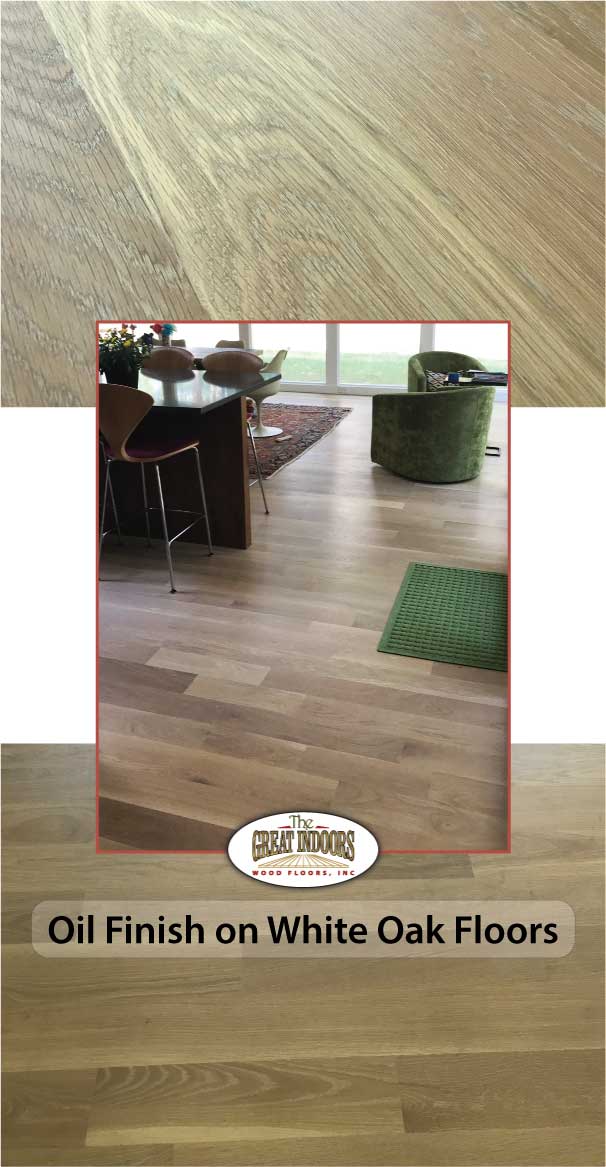Oil-finished Wood Floors
Oil finish on wood floors (sometimes called "craft oil") has been popular in Europe for many years. Finishing hardwood floors with oil creates a matte (or non-glossy) finish on the wood for a natural, vintage look. But beyond that, the oil treatment impregnates the wood, creating a natural protective barrier without the "plastic looking" finish of polyurethanes. (Urethane coatings simply create an artificial barrier on top of the wood.)
With oiled wood floors, oil soaks into the wood and protects the wood deeper than just on the surface, enhancing the woods' natural defenses against moisture and allowing it to breathe. Oil-finished floors using the new modern oil finishes are amazingly durable, easy to maintain, and easy to repair. Once the oil has penetrated the wood grain and dried, there is no oilyness or other tactile evidence that the wood has been treated... just a smooth, well-protected wood floor.
Oil finishing also allows us to still do other visual enhancements to the floor, such as wire-brushing, hand-scraping, whitewashing, etc. Example: We can wire-brush a wood floor and then oil finish, etc.

There are two types of oil floor coatings available:
- Oil finishes
- Hard wax oil finishes
The Oil Finishing Process:
For the first application of oil, floors are sanded and prepared just as in any refinishing project, although with a slightly rougher grit of surface to allow the oil to soak in completely and deeply. Once the floors are sanded and thoroughly cleaned of dust, the oil is applied smoothly and allowed to dry, sometimes with an "accelerator" application to speed the drying process. Multiple coats of oil can be used to create deeper colors, although, the products we use are designed to cover in one coat. "Water-popping" can also be employed to open the wood grain to absorb the oil more fully, which also tends to enhance the color.
A "Green" Wood Floor Solution:
Oil finishes and hard wax oil finishes contain minimal if any volatile organic compounds (VOCs) to pollute the environment in your home.
Maintenance of Oiled Wood Floors:
Maintenance of oiled or hard wax oil wood floors is relatively simple. Vacuuming and mopping (with minimal water) to remove dirt and dust, and occasional scrubbing with a soap specially made for oiled wood floors, such as RMC Surface Care from Rubio Monocoat or Bona Soap. Do not use all-purpose cleaners as they tend to leave a dull residue and may contain more water than you should use on wood floors.
Easy to Repair
If an oiled wood floor is damaged or just shows wear spots in the most used areas, repair can be done without sanding and refinishing the entire floor. A small section can be sanded and re-oiled to make an invisible (or nearly invisible) repair.
Wood Floor Oil Colors
There are many, many colors of craft oil available. When choosing colors, the buyer needs to be aware that the color and grain of the wood is a major contributor to the final color and hue of the floor. For example, a red oak floor coated with a light-colored oil will still appear with the natural hue of red oak. Craft oils enhance, protect and "tint" the wood, but do not cover the color or grain completely except in the very darkest of colors.
Rubio Monocoat is one of the leading purveyors of wood floor oils, and now Bona is entering the market with some fine products, too. Here are a color chart of available wood floor oil colors:


